Study on Urbanization Sustainability of Xinjiang in China: Connotation, Indicators and Measurement
Abstract
1. Introduction
2. Methodology and Research Data
2.1. Study Area
2.2. Methodology and Data Sources
2.2.1. Theoretical Foundations of the Sustainable Urbanization Index
- (1)
- Security and Stability: Prerequisites
- (2)
- Social integration: Inherent Requirements
- (3)
- Economic Vitality: The Core Driving Force
- (4)
- Happiness and Livability: The Goal
- (5)
- Ecological Health: An Important Guarantee
2.2.2. Entropy-Weighted TOPSIS
- (1)
- Construct Matrix X
- (2)
- Standardize Matrix X into Matrix Y
- (3)
- Determine the Weights for Evaluation Indicators
- (4)
- Build the weighted standardized matrix Zwhere .
- (5)
- Determine the positive (Z+) and negative (Z−) ideal solutions:
- (6)
- Calculate the Euclidean distance between each evaluation object and the positive/negative ideal solutions:
- (7)
- Calculate the relative approximation distance (Ci) of each evaluation object to the positive ideal solution:where 0 ≤ Ci ≤ 1; the larger the Ci value, the higher the ranking of the evaluation indicator and vice versa. In all the above formulas, i = 1, 2, …, m; while j = 1, 2, …, n.
2.2.3. Regional Analysis
2.3. Data Resources
3. Results
3.1. Status Quo and Characteristics of Urbanization Sustainability
3.1.1. Overall Characteristics
3.1.2. Dimensional Characteristics
3.2. Regional Characteristics of Urbanization Sustainability
4. Discussion
4.1. Dimensional Analysis of Urbanization Sustainability in Xinjiang
4.2. Diagnosis of Problems by Sub-Region
4.3. Political Implications
4.4. Strengths and Limitations
5. Conclusions
Author Contributions
Funding
Institutional Review Board Statement
Informed Consent Statement
Data Availability Statement
Acknowledgments
Conflicts of Interest
References
- Chen, M.; Ye, C.; Lu, D.; Sui, Y.; Guo, S. Cognition and construction of the theoretical connotation for new-type urbanization with Chinese characteristics. Acta Geogr. Sin. 2019, 74, 633–647. (In Chinese) [Google Scholar]
- Jiang, C.; Li, J.; Liu, J. Does urbanization affect the gap between urban and rural areas? Evidence from China. Socio Econ. Plan. Sci. 2022, 82, 101271. [Google Scholar] [CrossRef]
- Jiang, H.; Guo, H.; Sun, Z.; Xing, Q.; Zhang, H.; Ma, Y.; Li, S. Projections of urban built-up area expansion and urbanization sustainability in China’s cities through 2030. J. Clean. Prod. 2022, 367, 133086. [Google Scholar] [CrossRef]
- Angel, S.; Lamson-Hall, P.; Blei, A.; Shingade, S.; Kumar, S. Densify and Expand: A global analysis of recent urban growth. Sustainability 2021, 13, 3835. [Google Scholar] [CrossRef]
- Fan, J.; Liu, Y.; Chen, T.; Zhang, W.; Jin, F. The key strategies and innovative thinking for optimization on spatial pattern of urbanization in China. Bull. Chin. Acad. Sci. 2013, 28, 20–27. (In Chinese) [Google Scholar]
- Lu, D.; Yao, S. A scientific thought about urbanization progress in China. Hum. Geogr. 2007, 22, 1–5. (In Chinese) [Google Scholar]
- Lu, D.; Yao, S.; Li, G.; Liu, H.; Gao, X. Comprehensive analysis of the urbanization process based on China’s conditions. Econ. Geogr. 2007, 27, 883–887. (In Chinese) [Google Scholar]
- Yang, Z.; Yang, H.; Wang, H. Evaluating urban sustainability under different development pathways: A case study of the Beijing-Tianjin-Hebei region. Sustain. Cities Soc. 2020, 61, 102226. [Google Scholar] [CrossRef]
- Lu, Y.; Zhang, Y.; Cao, X.; Wang, C.; Wang, Y.; Zhang, M.; Zhang, Z. Forty years of reform and opening up: China’s progress toward a sustainable path. Sci. Adv. 2019, 5, 9413. [Google Scholar] [CrossRef]
- Ariken, M.; Zhang, F.; Chan, N.; Kung, H. Coupling coordination analysis and spatio-temporal heterogeneity between urbanization and eco-environment along the Silk Road Economic Belt in China. Ecol. Indic. 2021, 121, 107041. [Google Scholar] [CrossRef]
- Friedmann, J. Four theses in the study of China’s urbanization. Int. J. Urban Reg. Res. 2006, 30, 440–451. [Google Scholar] [CrossRef]
- Yigitcanlar, T.; Dur, F.; Dizdaroglu, D. Towards prosperous sustainable cities: A multiscalar urban sustainability assessment approach. Habitat Int. 2015, 45, 36–46. [Google Scholar] [CrossRef]
- Ameen, R.F.M.; Mourshed, M. Urban sustainability assessment framework development: The ranking and weighting of sustainability indicators using analytic hierarchy process. Sustain. Cities Soc. 2019, 44, 356–366. [Google Scholar] [CrossRef]
- Bibri, S.E. A foundational framework for smart sustainable city development: Theoretical, disciplinary, and discursive dimensions and their synergies. Sustain. Cities Soc. 2018, 38, 758–794. [Google Scholar] [CrossRef]
- Kovács, Z.; Farkas, J.; Szigeti, C.; Harangozó, G. Assessing the sustainability of urbanization at the sub-national level: The Ecological Footprint and Biocapacity accounts of the Budapest Metropolitan Region, Hungary. Sustain. Cities Soc. 2022, 84, 104022. [Google Scholar] [CrossRef]
- Xu, Z.; Zhang, Z. Review indicators of measuring sustainable development. China Popul. Resour. Environ. 2000, 10, 60–64. (In Chinese) [Google Scholar]
- Cheng, G.; Xu, Z.; Xu, J. Vision of integrated happiness accounting system in China. Acta Geogr. Sin. 2005, 60, 60–64. (In Chinese) [Google Scholar]
- Altamirano-Avila, A.; Martínez, M. Urban sustainability assessment of five Latin American cities by using SDEWES index. J. Clean. Prod. 2021, 287, 125495. [Google Scholar] [CrossRef]
- Foroozesh, F.; Monavari, S.M.; Salmanmahiny, A.; Robati, M.; Rahimi, R. Assessment of sustainable urban development based on a hybrid decision-making approach: Group fuzzy BWM, AHP, and TOPSIS–GIS. Sustain. Cities Soc. 2022, 76, 103402. [Google Scholar] [CrossRef]
- Moussiopoulos, N.; Achillas, C.; Vlachokostas, C.; Spyridi, D.; Nikolaou, K. Environmental, social and economic information management for the evaluation of sustainability in urban areas: A system of indicators for Thessaloniki, Greece. Cities 2010, 27, 377–384. [Google Scholar] [CrossRef]
- Fang, C.; Wei, Y.H.D. Evaluation on the sustainable development capacity and regularity of its regional differentiation in Hexi Region. Acta Geogr. Sin. 2001, 56, 561–569. (In Chinese) [Google Scholar]
- Ma, Y.X.; Zhang, Z.B. Evaluation of sustainable development of urbanization in Gansu Province and analysis of the influencing factors under SDGs framework. J. Lanzhou Univ. 2021, 57, 627–636. (In Chinese) [Google Scholar]
- Ma, Y.J.; Ai, X.P. Evaluation of Sustainable Urbanization Development in Jilin Province Based on the 2030 Sustainable Development Goals. Sci. Geogr. Sin. 2019, 39, 487–495. (In Chinese) [Google Scholar]
- Bahtebay, J.; Zhang, F.; Ariken, M.; Chan, N.; Tan, M. Evaluation of the coordinated development of urbanization-resources-environment from the incremental perspective of Xinjiang, China. J. Clean. Prod. 2021, 325, 129309. [Google Scholar] [CrossRef]
- Song, X.; Fan, Y.; Shan, L. The empirical study on the measurement and its effect factors of the coordinated development level of the New-Type urbanization in Xinjiang. Ecol. Econ. 2021, 37, 78–86. (In Chinese) [Google Scholar]
- An, X.; Anwaer, M. A study on new urbanization level evaluation index system of Xinjiang. Urban. Stud. 2013, 37, 23–27. (In Chinese) [Google Scholar]
- Zhang, Z.; Sun, H. Research in Spatial-Temporal Feature and Dynamic Factor in Xinjiang’s Urbanization: Based on Empirical Analysis in Nuclear Density and Quantile Model. J. Xinjiang Norm. Univ. 2016, 37, 141–148. (In Chinese) [Google Scholar]
- Du, H.; Tang, Y.; Zhang, Z. Regional characteristics and high-quality development path of urbanization in arid region of Xinjiang. Econ. Geogr. 2021, 41, 200–206. (In Chinese) [Google Scholar]
- Han, C.; Zheng, J.; Guan, J.; Yu, D.; Lu, B. Evaluating and simulating resource and environmental carrying capacity in arid and semiarid regions: A case study of Xinjiang, China. J. Clean. Prod. 2022, 338, 130464. [Google Scholar] [CrossRef]
- Liu, W.; Jiao, F.; Ren, L.; Xu, X.; Wang, J.; W, X. Coupling coordination relationship between urbanization and atmospheric environment security in Jinan City. J. Clean. Prod. 2018, 204, 1–11. [Google Scholar] [CrossRef]
- Bogers, M.; Biermann, F.; Kalfagianni, A.; Kim, R.E.; Treep, J.; de Vos, M.G. The impact of the Sustainable Development Goals on a network of 276 international organizations. Glob. Environ. Chang. 2022, 76, 102576. [Google Scholar] [CrossRef]
- Zheng, Y. Reflections on the construction of resilient cities under the background of new urbanization. City Disaster Reduct. 2017, 7, 61–65. (In Chinese) [Google Scholar]
- Sun, Y.; Zhai, B.; Saierjiang, H.; Chang, H. Disaster adaptation evolution and resilience mechanisms of traditional rural settlement landscape in Xinjiang, China. Int. J. Disaster Risk Reduct. 2022, 73, 102869. [Google Scholar] [CrossRef]
- Sun, C.; Du, H. Change and influencing factors of ecological efficiency in the process of urbanization in Xinjiang. Chin. J. Ecol. 2022. Available online: https://kns.cnki.net/kcms/detail/21.1148.Q.20220610.1100.010.html (accessed on 10 June 2022). (In Chinese).
- Gao, J. The idea of accelerating Xinjiang’s new-type urbanization development. J. Party Sch. 2021, 4, 86–90. (In Chinese) [Google Scholar]
- Song, L. A research in the power mechanisms and mode selection of new-type urban development in Xinjiang. J. Xinjiang Univ. 2012, 40, 1–6. (In Chinese) [Google Scholar]
- Gao, Z.; Shi, L.; Han, Y. Study on the influence of urban-rural economic gap on Xinjiang’s high quality development. Soc. Sci. Xinjiang 2022. Available online: https://kns.cnki.net/kcms/detail/65.1211.f.20220725.1215.004.html (accessed on 27 July 2022). (In Chinese).
- Duan, S.; Yang, X.; Cen, X. A Comprehensive Evaluation of Regional Integrated Development of Production and City based on Entropy Method: Example as Xinjiang Uygur Autonomous Region. J. Urban Stud. 2018, 7, 23–27. (In Chinese) [Google Scholar]
- Jin, Y. Study on urban economic vatality index in China. Sci. Geogr. Sin. 2007, 27, 9–16. (In Chinese) [Google Scholar]
- Yang, H.; Li, S.; Ye, Y.; Yang, X. Multi-Dimension Monitoring System for Regional Economy: Exploration and Practice in Xinjiang Autonomous Region. Procedia Comput. Sci. 2014, 31, 318–327. [Google Scholar] [CrossRef]
- Gu, H. Discussion on the coordinated development of Xinjiang regional economy from the perspective of Silk Road Economic Belt. J. Northwest Univ. Natl. 2016, 5, 99–109. (In Chinese) [Google Scholar]
- Lv, B.; Zhang, X. Study on coordination of urbanization and economic development in Xinjiang. Arid. Land Geogr. 2002, 25, 189–192. (In Chinese) [Google Scholar]
- Li, J.; Lei, J.; Li, S.; Yang, Z.; Tong, Y.; Zhang, S.; Duan, Z. Spatiotemporal analysis of the relationship between urbanization and the eco-environment in the Kashgar metropolitan area, China. Ecol. Indic. 2022, 135, 108524. [Google Scholar] [CrossRef]
- Sun, L.; Miao, C.; Yang, L. Ecological-economic efficiency evaluation of green technology innovation in strategic emerging industries based on entropy weighted TOPSIS method. Ecol. Indic. 2017, 73, 554–558. [Google Scholar] [CrossRef]
- Zhao, D.; Li, C.; Wang, Q.; Yuan, J. Comprehensive evaluation of national electric power development based on cloud model and entropy method and TOPSIS: A case study in 11 countries. J. Clean. Prod. 2020, 277, 123190. [Google Scholar] [CrossRef]
- Zhang, X. Influence of desert mineral resource exploitation on the spatial structure of the urban system in Xinjiang. Sci. China Ser. D 2002, 45, 180–184. [Google Scholar] [CrossRef]
- Schneider, A.; Chang, C.; Paulsen, K. The changing spatial form of cities in Western China. Landsc. Urban Plan. 2015, 135, 40–61. [Google Scholar] [CrossRef]
- Yang, Z.; Gao, X.; Lei, J. Fuzzy comprehensive risk evaluation of aeolian disasters in Xinjiang, Northwest China. Aeolian Res. 2021, 48, 100647. [Google Scholar] [CrossRef]
- Ma, Y. Current employment operation characteristics, problems and countermeasures in Xinjiang. North. Econ. 2022, 4, 61–63. (In Chinese) [Google Scholar]
- Yang, F.; Yang, D. The measurement of basic public services quality and the analysis of their differences among prefectures. J. Arid. Land Resour. Environ. 2014, 28, 37–42. (In Chinese) [Google Scholar]
- Wu, S.; Guo, W. Research on coordination between urban-rural integration and economic development level in Xinjiang based on VAR model. J. Yili Norm. Univ. 2020, 38, 29–37. (In Chinese) [Google Scholar]
- Wang, J.; Lin, L.; Zhu, Y. Migrants’ hukou transfer intention and dynamics in western ethnic minority regions: Evidence from Xinjiang Autonomous Region. Prog. Geogr. 2018, 37, 1140–1149. (In Chinese) [Google Scholar]
- Liu, G.; Ye, J.; Ju, W. Analysis and prediction of the coordinated development of resource utilization-ecological-environment-New Urbanization coupling: Taking Xinjiang as an example. Resour. Dev. Mark. 2021, 37, 800–806. (In Chinese) [Google Scholar]
- Jing, Y.; Zhang, F.; He, Y.; Kung, H.; Johnson, V.; Arikena, M. Assessment ofspatial and temporal variation of ecological environment quality in Ebinur Lake Wetland National Nature Reserve, Xinjiang, China. Ecol. Indic. 2020, 110, 105874. [Google Scholar] [CrossRef]
- Yan, Y.; Chai, Z.; Yang, X.; Simayi, Z.; Yang, S. The temporal and spatial changes of the ecological environment quality of the urban agglomeration on the northern slope of Tianshan Mountain and the influencing factors. Ecol. Indic. 2021, 133, 108380. [Google Scholar]
- Zhang, J.; Rong, C.; Ma, Y. Spatial and temporal differences and driving factors of the green development of urbanization in Xinjiang. Arid. Land Geogr. 2022, 45, 251–262. (In Chinese) [Google Scholar]
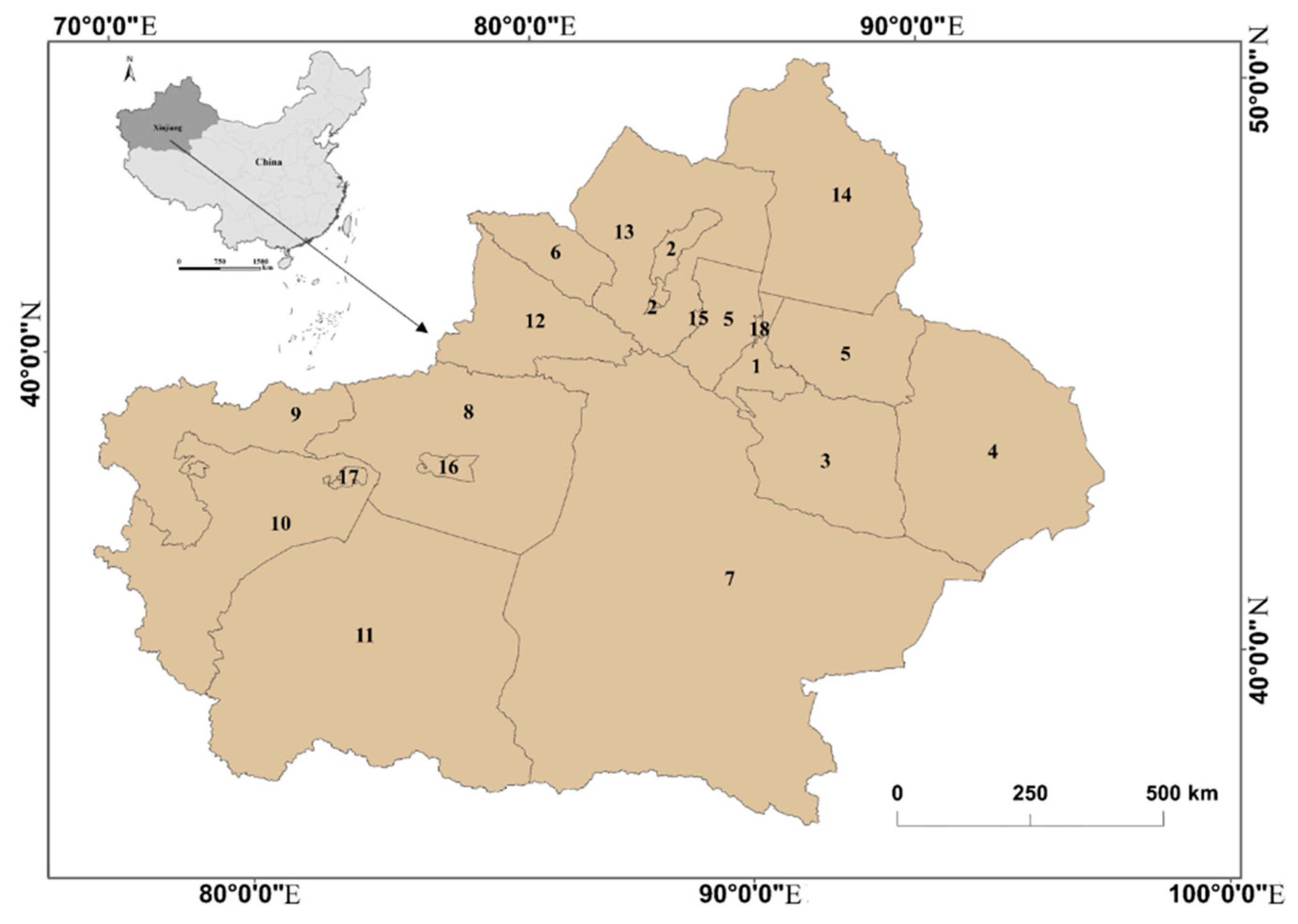
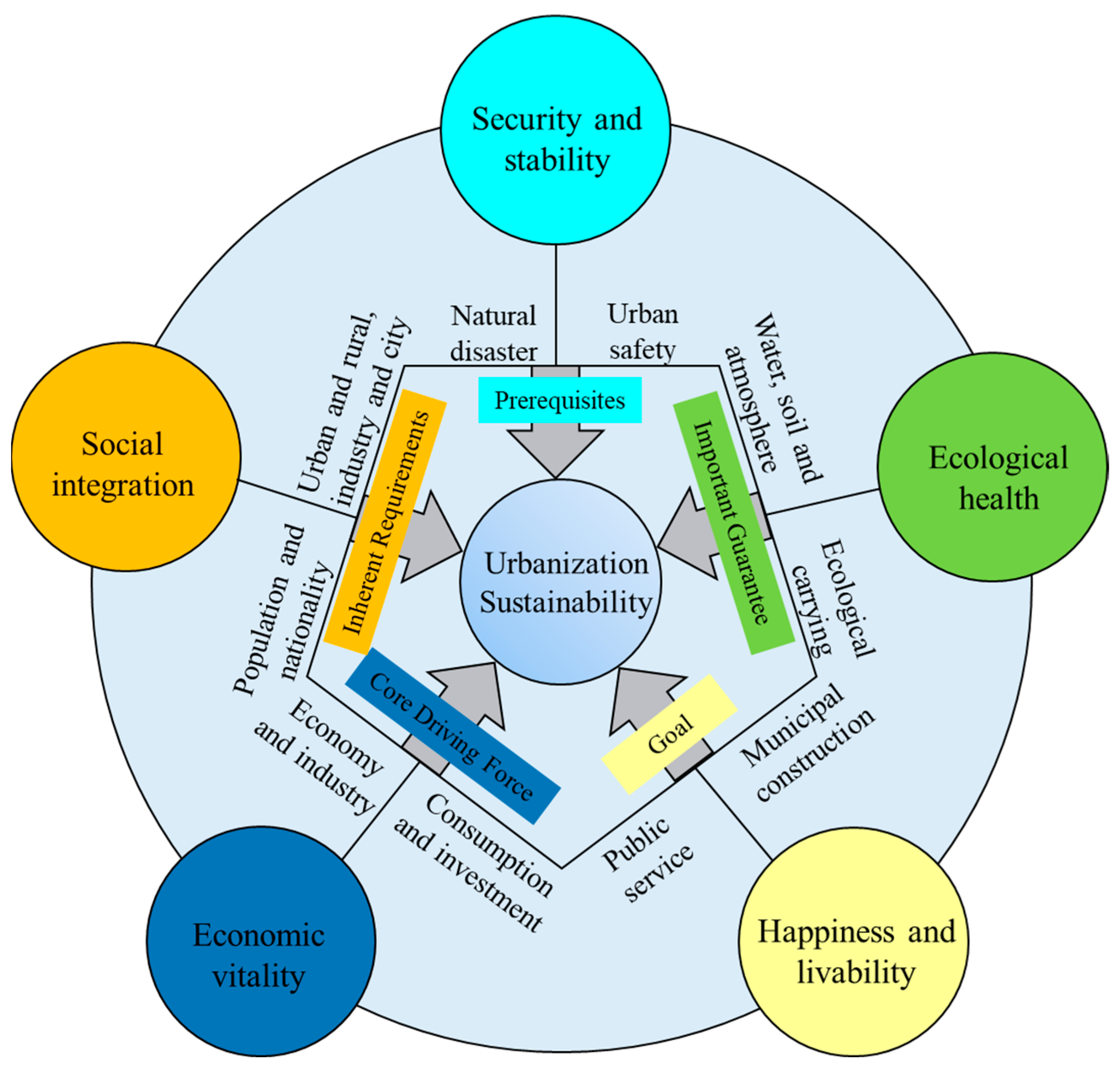
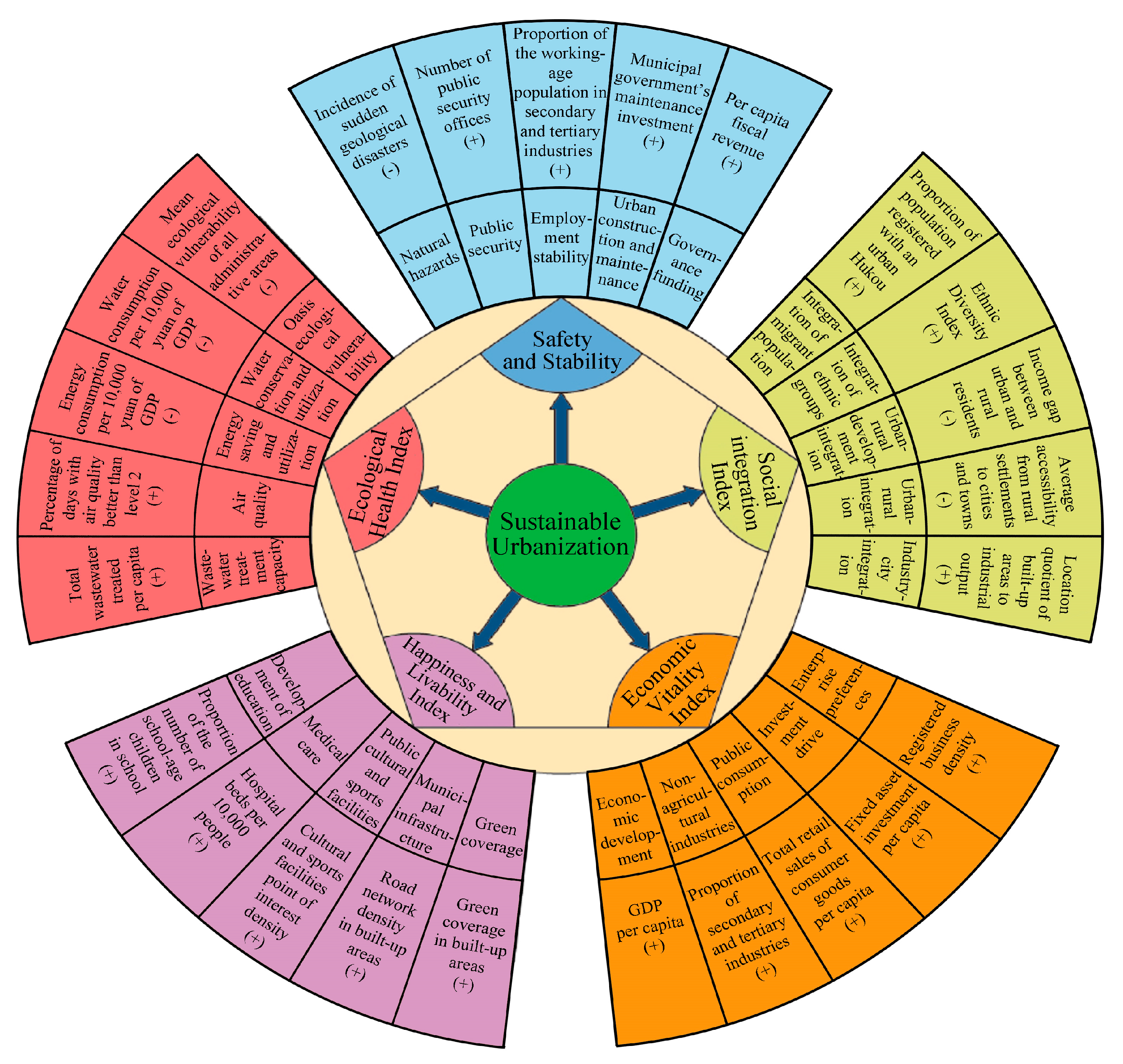
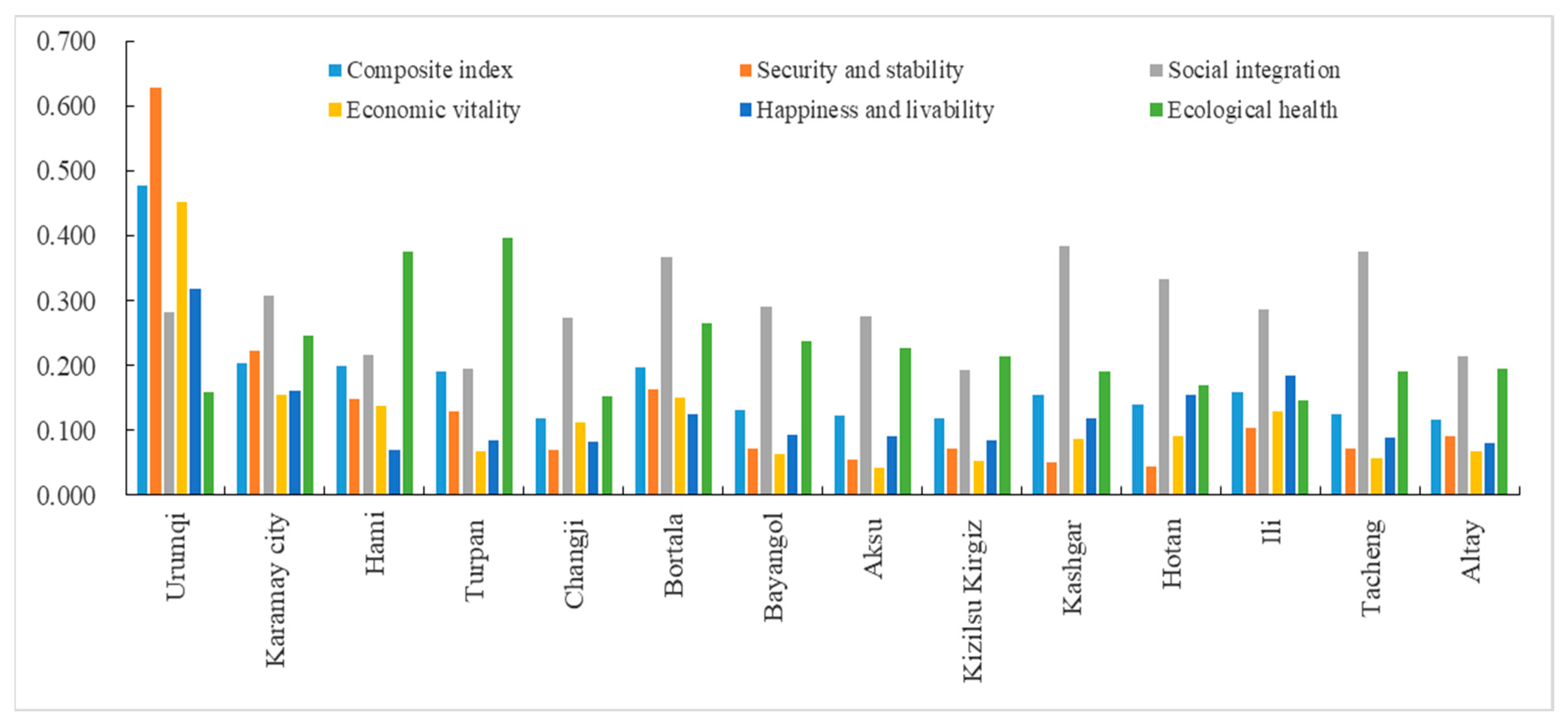
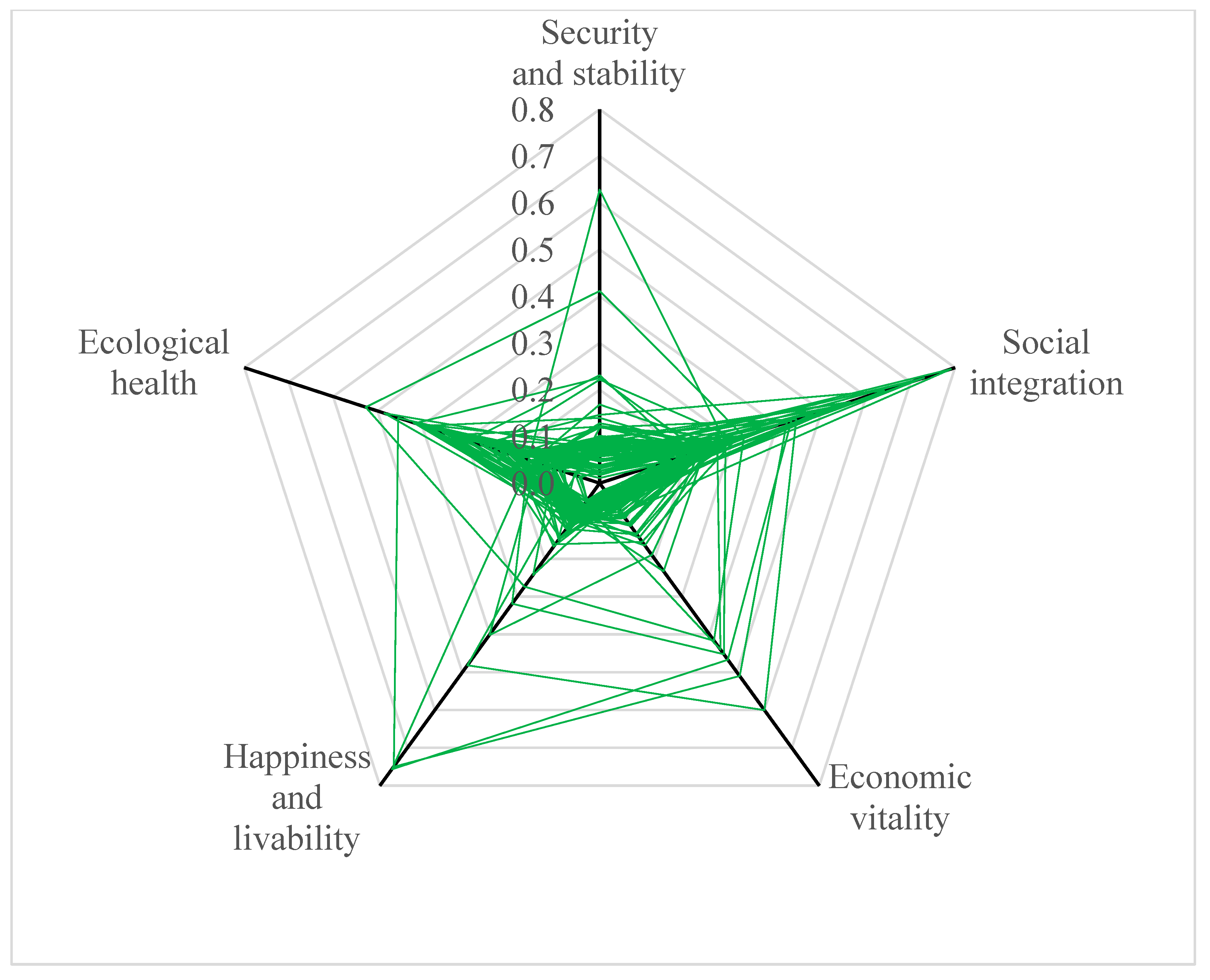

| Dimension | Indicator | Meaning | Sources |
|---|---|---|---|
| Safety and Stability (SS) | Natural disaster stress degree | Level of sudden geological disasters in Xinjiang− | Assessment map of resources and environment carrying capacity in Xinjiang (Resource and Environment Science and Data Center, CAS) |
| Urban public safety level | Number of public security organs+ | POI data, Baidu Map open platform in June 2020 | |
| Urban employment stability | The proportion of the population working in the secondary and tertiary industries+ | County Statistical Yearbook | |
| Urban construction and maintenance level | Municipal maintenance investment+ | City/County Construction Statistical Yearbook | |
| Management fund security degree | Per capita fiscal revenue+ | County Statistical Yearbook | |
| Social Integration Index (SI) | Immigrant integration degree | Urbanization rate of registered population+ | Xinjiang Statistical Yearbook |
| Diversity of ethnic integration | Ethnic Diversity Index+ | Ethnic Volume of the Sixth Population Census | |
| Integration degree of urban and rural development | The income gap between urban and rural residents− | Statistical Yearbook of Xinjiang (Prefecture level instead) | |
| Urban–rural integration | Mean accessibility of rural settlements to towns− | Calculated by GIS spatial neighborhood analysis | |
| City and industry development integration degree | The ratio of built-up area proportion to industrial output proportion+ | County Statistical Yearbook and City/County Construction Statistical Yearbook | |
| Economic Vitality Index (EV) | Economic development level | Per capita GDP+ | County Statistical Yearbook |
| Non-agricultural industry vitality | The proportion of secondary and tertiary industries+ | County Statistical Yearbook | |
| Public consumption vitality | Per capita retail sales of consumer goods+ | County Statistical Yearbook | |
| Investment drives level | Per capita fixed asset investment+ | County Statistical Yearbook | |
| Enterprise preference | Registered enterprise density+ | Enterprise POI database | |
| Happiness and Livability Index (HL) | Education development level | The proportion of students in school+ | County Statistical Yearbook |
| Medical security level | Number of beds per ten thousand people+ | County Statistical Yearbook | |
| Culture and sports sharing level | Cultural and sports facilities POI density+ | POI data, Baidu Map open platform in June 2020 | |
| Municipal construction level | Road network density in built-up area+ | City/County Construction Statistical Yearbook | |
| Green space cover level | Green coverage rate of built-up area+ | City/County Construction Statistical Yearbook | |
| Ecological Health Index (EH) | Sewage treatment capacity | Total sewage treatment per capita+ | City/County Construction Statistical Yearbook |
| Air quality level | The proportion of days with better air quality than Grade II+ | City/County Construction Statistical Yearbook | |
| Energy conservation level | Energy consumption per ten-thousand-yuan GDP− | City/County Construction Statistical Yearbook | |
| Water resource conservation level | Water consumption of ten-thousand-yuan GDP− | City/County Construction Statistical Yearbook | |
| Oasis ecological vulnerability | Average value of ecological vulnerability of administrative region− | Resource and Environment Science and Data Center, CAS |
| Zone | Variable | Mean Value | Standard Deviation | Minimum | Maximum | Region |
|---|---|---|---|---|---|---|
| High-sustainability areas | Economic Vitality | 0.4526 | 0.0000 | 0.4526 | 0.4526 | Urumqi |
| Safety and Stability | 0.6282 | 0.0000 | 0.6282 | 0.6282 | ||
| Happiness and Livability | 0.3190 | 0.0000 | 0.3190 | 0.3190 | ||
| Social integration | 0.2829 | 0.0000 | 0.2829 | 0.2829 | ||
| Ecological Health | 0.1599 | 0.0000 | 0.1599 | 0.1599 | ||
| Balanced-sustainability areas | Economic Vitality | 0.1113 | 0.0334 | 0.0564 | 0.1551 | Karamay, Kashgar, Hotan, Tacheng, Changji Hui Autonomous Prefecture, Bortala Mongol Autonomous Prefecture, and Ili Kazakh Autonomous Prefecture |
| Safety and Stability | 0.1033 | 0.0610 | 0.0435 | 0.2219 | ||
| Happiness and Livability | 0.1306 | 0.0347 | 0.0835 | 0.1836 | ||
| Social integration | 0.3318 | 0.0413 | 0.2726 | 0.3836 | ||
| Ecological Health | 0.1947 | 0.0421 | 0.1472 | 0.2662 | ||
| Low-sustainability areas | Economic Vitality | 0.0718 | 0.0309 | 0.0426 | 0.1379 | Turpan, Hami, Bayingolin Mongol Autonomous Prefecture, Aksu, Altay, and Kizilsu Kyrgyz Autonomous Prefecture |
| Safety and Stability | 0.0945 | 0.0333 | 0.0554 | 0.1485 | ||
| Happiness and Livability | 0.0836 | 0.0077 | 0.0691 | 0.0922 | ||
| Social integration | 0.2308 | 0.0382 | 0.1926 | 0.2897 | ||
| Ecological Health | 0.2742 | 0.0804 | 0.1960 | 0.3975 |
Disclaimer/Publisher’s Note: The statements, opinions and data contained in all publications are solely those of the individual author(s) and contributor(s) and not of MDPI and/or the editor(s). MDPI and/or the editor(s) disclaim responsibility for any injury to people or property resulting from any ideas, methods, instructions or products referred to in the content. |
© 2023 by the authors. Licensee MDPI, Basel, Switzerland. This article is an open access article distributed under the terms and conditions of the Creative Commons Attribution (CC BY) license (https://creativecommons.org/licenses/by/4.0/).
Share and Cite
Kang, L.; Xia, S. Study on Urbanization Sustainability of Xinjiang in China: Connotation, Indicators and Measurement. Int. J. Environ. Res. Public Health 2023, 20, 2535. https://doi.org/10.3390/ijerph20032535
Kang L, Xia S. Study on Urbanization Sustainability of Xinjiang in China: Connotation, Indicators and Measurement. International Journal of Environmental Research and Public Health. 2023; 20(3):2535. https://doi.org/10.3390/ijerph20032535
Chicago/Turabian StyleKang, Lei, and Siyou Xia. 2023. "Study on Urbanization Sustainability of Xinjiang in China: Connotation, Indicators and Measurement" International Journal of Environmental Research and Public Health 20, no. 3: 2535. https://doi.org/10.3390/ijerph20032535
APA StyleKang, L., & Xia, S. (2023). Study on Urbanization Sustainability of Xinjiang in China: Connotation, Indicators and Measurement. International Journal of Environmental Research and Public Health, 20(3), 2535. https://doi.org/10.3390/ijerph20032535





